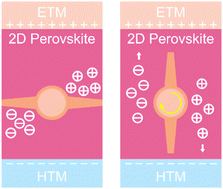Universal approach toward high-efficiency two-dimensional perovskite solar cells via a vertical-rotation process†
Abstract
The emerging 2D perovskites exhibit superior stability and similar optoelectronic attributes compared to the 3D analogues, but their strong exciton-binding energy and inferior interlayer charge-transport reduce dramatically the device performance. Herein, we report a universal approach towards high-efficiency 2D perovskite solar cells (PSCs) by using the synergistic effect of NH4Cl and H2O to rotate the crystallographic orientation of 2D systems. The preferential adsorption of NH4Cl to the (202) crystal plane and the accelerated deprotonation of NH4+ by H2O guide the crystal growth of the 2D framework towards vertical out-of-plane orientation, which strongly improves the 2D crystallinity, charge mobility, and carrier lifetime. As a representative, (PEA)2(MA)3Pb4I13-based PSCs (n ≤ 4) prepared via the vertical-rotation process achieve a champion power conversion efficiency (PCE) of 17.03%, among the best PCEs reported for 2D PSCs. These findings offer a universal approach to rotate the orientation of 2D perovskites for efficient photovoltaics regardless of the perovskite composition.



 Please wait while we load your content...
Please wait while we load your content...